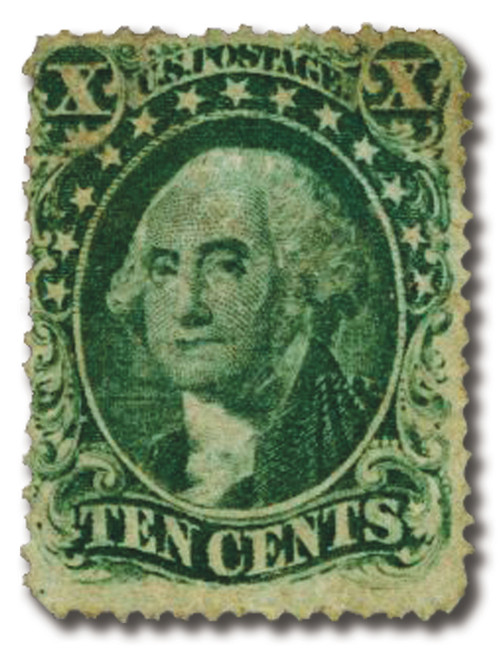
1857-61 10c Washington, T2 & T3
# 32,33 - 1857-61 10c Washington, T2 & T3
$5,000.00
U.S. #32,33 Unused pair with small flaws
Series of 1857-61 10¢ Washington
#32 Type II and #33 Type III
First Day of Issue: July 27, 1857
Quantity issued: 2,900,000 (estimate)
Printed by: Toppan, Carpenter & Co.
Printing Method: Flat plate
Watermark: None
Perforation: 15.5
Color: Green
There are five major varieties of the Series of 1857-61 10¢ Washington stamp. Types I through III (U.S. #31-33) are basically the same as the imperforate 10¢ types (U.S. #13-15). The bottom outer line is broken and both lower shells are cut away on the Type II stamp, which is the most common of the types.
Quantity issued: 2,900,000 (estimate)
Printed by: Toppan, Carpenter & Co.
Printing Method: Flat plate
Watermark: None
Perforation: 15.5
Color: Green
There are five major varieties of the Series of 1857-61 10¢ Washington stamp. Types I through III (U.S. #31-33) are basically the same as the imperforate 10¢ types (U.S. #13-15). The bottom outer line is broken and both lower shells are cut away on the Type II stamp, which is the most common of the types.
America’s First Perforated Stamp Series
When the world’s first postage stamps were released, no provision was made for separating the stamps from one another. Post office clerks and stamp users merely cut these “imperforates” apart with scissors or tore them along the edge of a metal ruler. A device was needed which would separate the stamps more easily and accurately.
In 1847, Irishman Henry Archer patented a machine that punched holes horizontally and vertically between rows of stamps. Now stamps could be separated without cutting. Perforations enabled stamps to adhere better to envelopes. He sold his invention to the British Treasury in 1853. That same year, Great Britain produced its first perforated stamps.
The 1857-61 issues were the first perforated U.S. stamps. Their designs were reproduced from the imperforate plates of 1851.
U.S. #32,33 Unused pair with small flaws
Series of 1857-61 10¢ Washington
#32 Type II and #33 Type III
First Day of Issue: July 27, 1857
Quantity issued: 2,900,000 (estimate)
Printed by: Toppan, Carpenter & Co.
Printing Method: Flat plate
Watermark: None
Perforation: 15.5
Color: Green
There are five major varieties of the Series of 1857-61 10¢ Washington stamp. Types I through III (U.S. #31-33) are basically the same as the imperforate 10¢ types (U.S. #13-15). The bottom outer line is broken and both lower shells are cut away on the Type II stamp, which is the most common of the types.
Quantity issued: 2,900,000 (estimate)
Printed by: Toppan, Carpenter & Co.
Printing Method: Flat plate
Watermark: None
Perforation: 15.5
Color: Green
There are five major varieties of the Series of 1857-61 10¢ Washington stamp. Types I through III (U.S. #31-33) are basically the same as the imperforate 10¢ types (U.S. #13-15). The bottom outer line is broken and both lower shells are cut away on the Type II stamp, which is the most common of the types.
America’s First Perforated Stamp Series
When the world’s first postage stamps were released, no provision was made for separating the stamps from one another. Post office clerks and stamp users merely cut these “imperforates” apart with scissors or tore them along the edge of a metal ruler. A device was needed which would separate the stamps more easily and accurately.
In 1847, Irishman Henry Archer patented a machine that punched holes horizontally and vertically between rows of stamps. Now stamps could be separated without cutting. Perforations enabled stamps to adhere better to envelopes. He sold his invention to the British Treasury in 1853. That same year, Great Britain produced its first perforated stamps.
The 1857-61 issues were the first perforated U.S. stamps. Their designs were reproduced from the imperforate plates of 1851.











